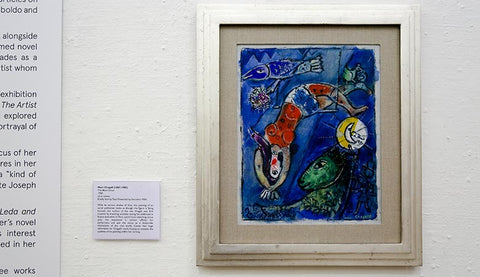Marc Chagall: an introduction

Inspired by the work The Blue Circus in the current exhibition Strange Worlds: The Vision of Angela Carter, marketing intern Naomi Weeks provides a brief introduction to Marc Chagall.
“If I create from the heart, nearly everything works. If from the head, almost nothing”
Marc Chagall
'Whenever I look at a Chagall, I am instantly swept away into a fantastical world of folklore and imagination. Whether it be flying goats, Eiffel towers or a touching expression of love to his beloved Bella, Chagall’s semi-surreal, semi-cubist and always enchanting works are beloved throughout the world.'
'The eldest of nine, Chagall grew up in a small town near Vitebsk, Belarus, and attended a local religious school. The Jewish teachings he learned there, as well as local folklore, would later inform much of his work. After studying painting for a while in Russia, he left for Paris in 1911 to continue his career as an artist. Working alongside other modernists such as Picasso and Braque, he undoubtedly had cubist influences; yet maintained to work in a figurative style despite his contemporaries growing interest in abstraction.'
'Returning to Russia in 1914, Chagall’s plans to visit and then return to France were disrupted by the start of World War I, and he became trapped in his own country. However, this period has often been read as a period of contentment for the artist, much influenced by the domestic bliss he found in his marriage to Bella in 1915. His painting echoed the harmony and happiness of his life; it is here we see scenes of flying lovers, metaphors of contentment floating across the Russian sky. The work in this period draws on his Jewish roots and nostalgia, but serves especially as a series of love letters dedicated to Bella (who died in 1944) and his daughter Ida.'
'After the Bolshevik Revolution of 1917, Chagall was recruited as the Commissar of Arts for Vitebsk and later moved back to Paris and then to New York in 1941, after his daughter sought asylum for her family during the Second World War. He continues to be celebrated and exhibited around the world today.'